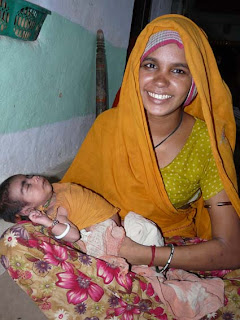
Mandora was afraid about what would happen during the delivery. She did not know how old she was, probably around 18 but this was her first pregnancy and she had severe stomach pains. But as soon as she entered the hospital feelings of relief swept over her. Mandora had a sense that she was safe now and everything would be alright.
She had been preparing for this day for some time. Three months after Mandora fell pregnant she visited her village health worker, Shyam Lata. Shyam took her through various steps to ensure Mandora could give birth in a hospital and not in the village with the traditional midwife, known as a dai in Hindi.
For Shyam, one of the most crucial steps was persuading Mandora’s family, in particular her husband Ram Charan and father-in-law that giving birth in hospital was the safest option for mother and child. Luckily Shyam had recieved training from GVNML which gave her confidence in convincing them.
First, Shyam took Mandora to the government run Baby Childcare Centre to register her pregnancy, her course of tetanus immunisations was started and she was given iron tablets. It is essential to have an appropriate vehicle to get to hospital. A lack of planning means some pregnant women are taken on motorbikes or tractors, leading to dangerous deliveries during the journey. But Mandora’s family arranged to hire a jeep in the village and already knew the charges and the right mobile number to call when they needed it.
It was the final month of her pregnancy and when Mandora’s stomach pains came, Shyam and the village dia were called but after 2 hours the contractions had not increased. They decided to take her to hospital but were sure to carry the safe delivery kit with them, which includes salvon, a clean knife for cutting the umbilical cord and a safety thread in case the baby was born on route. Shyam had called ahead to the hospital so the midwife was ready and expecting Mandora. At Nagar, the nearest hospital, the doctors gave Mandora glucose and an injection to give an easy delivery. A healthy baby boy was born on 10th April 2010 and named Vikash. The baby was immunised and the mother given pain relief and antibiotics.
Giving birth in a hospital is quite a new idea to the families of Itakhoi village. Shyam has been a health worker here for 7 years and tries to show people the downfalls of traditional delivery practices and offers them advice backed by modern science. There are many misconceptions- women don’t breastfeed their new born children for the first 5 hours, giving them Indian sweets instead; the umbilical cord is cut with a knife also used for cutting crops and a mixture of turmeric and ghee is used as an antiseptic.
After giving birth, tradition states the mother and baby must sleep on a floor covered with jute bags and ash until the mother and baby’s first bath. The date for this wash is often set by a priest and could be up to 10 days later. It is thought that taking iron and folic acid supplements when pregnant creates large babies which will be hard to deliver, and eating too much could squash the baby. For these reasons the woman is often weak when she gives birth, leading to more health complications for her and her child and sadly, maternal death and child mortality.
Since 1994 around 500 dias and 225 health workers have been trained by GVNML in 250 villages. This has dramatically increased the number of safe deliveries from 10% to 75%.
No comments:
Post a Comment